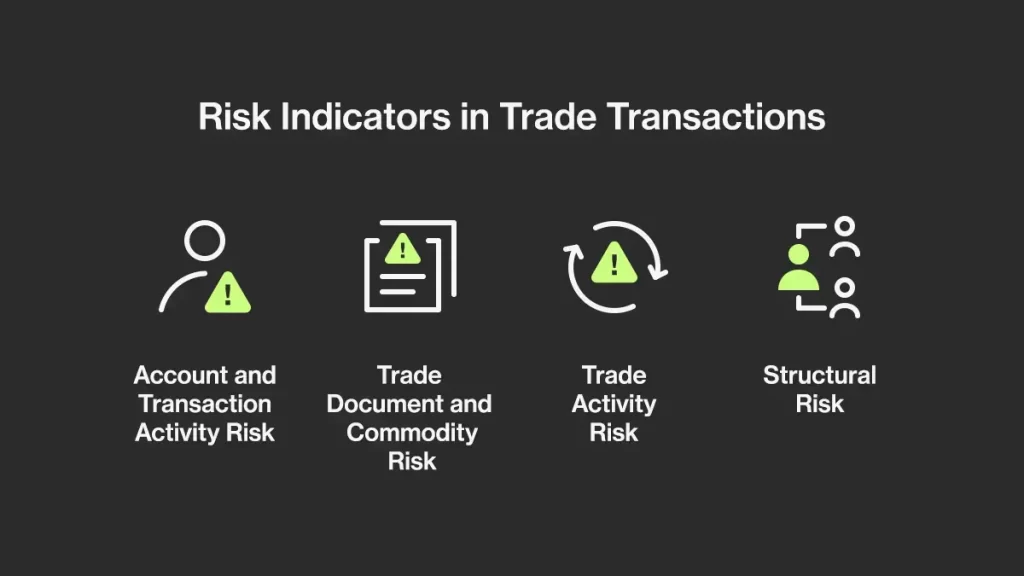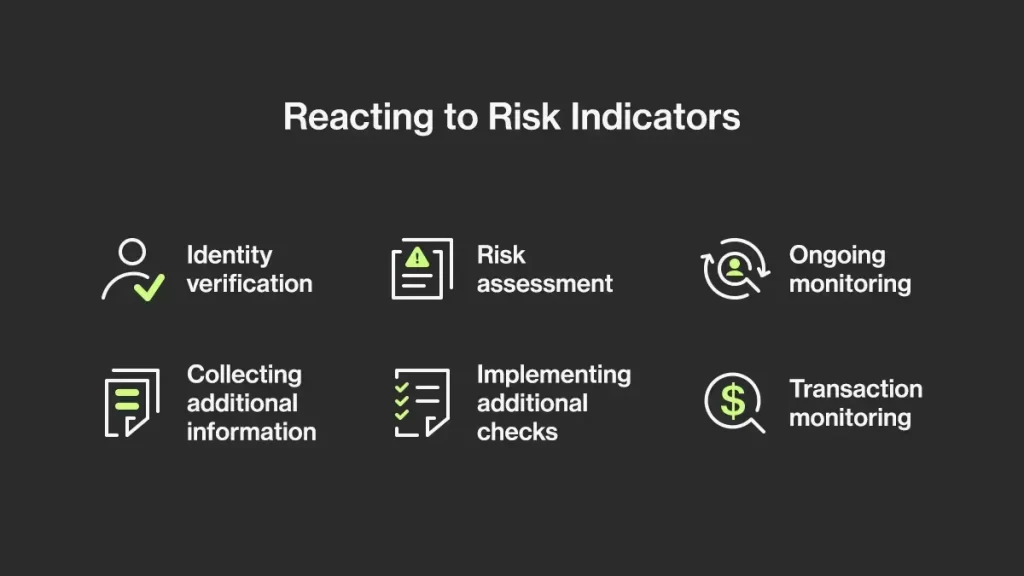Trade transactions inherently carry risks that can jeopardise the financial stability of businesses. Specifically, in trade-based activities like exports, the potential for money laundering and terrorist financing poses a significant threat. Criminals exploit trade transactions to obscure or generate illegal funds, assuming roles as importers or exporters of goods or services. If companies fail to report any suspicious activity that could be linked to trade-based money laundering, they could face legal consequences and hefty fines.
To address money laundering and terrorist financing risks effectively, organisations must implement robust trade-based Anti-Money Laundering (AML) measures and controls. Enhanced Due Diligence (EDD) emerges as a crucial tool, involving meticulous scrutiny of customers, their trade businesses, and related activities. Conducting EDD prior to onboarding to search for warning signs in trade-related transactions ensures a proactive approach.
Risk Indicators in Trade Transactions
The Financial Action Task Force (FATF) identifies 4 types of risk indicators to look out for when dealing with trade transactions. As FATF points out, the existence of a single indicator does not warrant suspicion on its own, however, does require closer examination.

Account and Transaction Activity Risk
- Late changes to payment arrangements for transactions, redirecting payments or altering scheduled payment details.
- Unexpectedly high number or value of transactions inconsistent with stated business activity.
- An account acting as a „pay-through” or „transit” account with rapid, high-volume transactions and small end-of-day balance.
- Frequent deposits in cash transferred to entities in free trade zones or offshore jurisdictions without a business relationship.
- Splitting incoming wire transfers from trade-related accounts to non-related multiple bank accounts.
- Payments for imported commodities made by an entity other than the consignee, without clear economic reasons.
- Consistent cash deposits or transactions just below reporting thresholds otherwise known as structuring transactions.
- Rapid and significant increase in transaction activity followed by dormancy.
- Unusual transactions sent or received in large round amounts deemed suspicious in specific sectors.
- Circular routing of payments through multiple foreign accounts.
Trade Document and Commodity Risk
- Inconsistencies across contracts, invoices, or trade documents, such as contradictory names or differing prices.
- Fees or prices in documents not in line with commercial considerations, inconsistent with market value, or significantly fluctuating.
- Vague descriptions of traded commodities in contracts or invoices.
- Missing, counterfeit, or modified trade or customs documents supporting transactions.
- Simple contracts supporting complex trade transactions.
- Significant mismatches between registered imports/exports and corresponding foreign bank transfers.
- Commodities imported with falsified documents within temporary importation regimes.
- Commodities routed through multiple jurisdictions without economic or commercial justification.
Trade Activity Risk
- Inconsistent trade activity with the stated line of business, such as a car dealer exporting clothing or a precious metals dealer importing seafood.
- Engagement in complex trade deals with numerous third-party intermediaries in incompatible lines of business.
- Inconsistent transactions, shipping routes, or methods with standard business practices.
- Unconventional or overly complex use of financial products, such as extended use of letters of credit without apparent reason.
- Consistently displaying unreasonably low profit margins in trade transactions.
- Purchasing commodities beyond economic capabilities, financed through sudden influxes of cash transactions or third-party transfers.
- Newly formed or recently re-activated entities engaging in high-volume trade activities in sectors with high market entry barriers.
Structural Risk
- The structure of a trade entity seems overly complicated and illogical, involving shell companies or entities registered in high-risk jurisdictions.
- A trade entity is registered or has offices in a jurisdiction with weak AML/CFT compliance.
- Registration at an address with mass registration characteristics, such as high-density residential buildings or post-box addresses, raises concerns.
- Business activities of a trade entity don’t align with the stated address, like using residential properties without a reasonable explanation.
- Lack of online presence or an online presence inconsistent with the stated line of business.
- Notable absence of typical business activities, such as payroll transactions or transactions related to operating costs and tax remittances.
- Owners or senior managers acting as nominees to hide beneficial ownership.
- Presence of the trade entity or its leadership in negative news related to money laundering, fraud, tax evasion, or other criminal activities.
- Maintaining a minimal number of staff inconsistent with traded commodities’ volume.
- Use of a trade entity’s name that mimics a well-known corporation, potentially to create a false association.
- Unexplained periods of dormancy in the trade entity’s operations.
- Non-compliance with regular business obligations like filing VAT returns.
Reacting to Risk Indicators

At the start of the working relationship, companies are required to perform Customer Due Diligence measures:
- Identity verification: During onboarding, organisations must verify the customer’s identity, assessing their behaviour and intended service use. This involves collecting details about natural persons or legal entities, including names and ID documents.
- Risk assessment: Organisations need to conduct checks on sanctions, reputational risk media, and PEP lists. They also validate ultimate beneficial ownership, shareholding structure, and undertake other processes to determine the customer’s risk score.
- Ongoing monitoring: Automated checks are employed to ensure that any changes in client information are promptly identified.
If the initial process or the ongoing monitoring shows one of the above listed red flag indicators, EDD measures must be performed as well:
- Collecting additional information: This step involves obtaining supplementary information such as proof of address, identification of a legal entity’s management, business sector details, or any other data that provides a comprehensive view of the client.
- Implementing additional checks: Organisations should conduct robust and extensive checks. For example, reputational risk media screening can swiftly assess a client’s reputation and potential involvement in criminal activities.
- Transaction monitoring: Analysing transaction history and monitoring ongoing transactions aids in establishing a client’s business relationship and detecting any suspicious activity.
In cases when information such as the source of UBO funds cannot be identified, companies must provide detailed documentation of their attempts to find this information.
In addition, EDD measures must always be applied if the business relationship entails a higher risk of money laundering or terrorist financing, if the business is established or has its registered office in one of FATF’s high-risk jurisdictions.
The failure to identify and report potential money launderers may lead to legal consequences, including hefty fines. On top of this, ignoring common warning signs of money laundering and terrorist financing can result in the loss of reputation for any company involved.
How Ondato can Help with Enhanced Due Diligence and Trade-Based AML
Ondato’s EDD solution helps companies prevent money laundering and terrorist financing with tools such as sanctions and PEP screening, reputational risk media checks, UBO identification, and many more. The solutions can be fully adapted to the client’s jurisdiction, ensuring they are always compliant with the AML regulations most relevant to them.
Ondato ensures any regulatory changes are reacted to in a timely manner, helping companies update their processes when needed.
Our Sanctions data is updated every 3 hours, 24/7, all information is checked with global registries to ensure accuracy, potential PEPs are checked against over 16 million PEP profiles.
With the help of our partners, we also provide aid in finding the right transaction monitoring tool for any company based on years of expertise.


